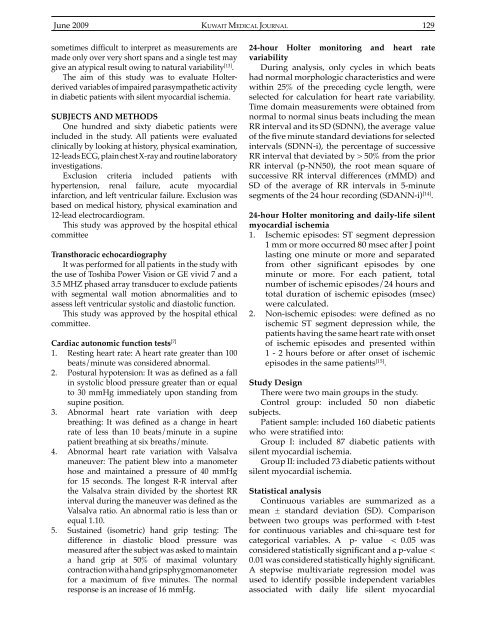June 09-41-2.indd - Kma.org.kw
June 09-41-2.indd - Kma.org.kw
June 09-41-2.indd - Kma.org.kw
Create successful ePaper yourself
Turn your PDF publications into a flip-book with our unique Google optimized e-Paper software.
<strong>June</strong> 20<strong>09</strong>KUWAIT MEDICAL JOURNAL 129sometimes difficult to interpret as measurements aremade only over very short spans and a single test maygive an atypical result owing to natural variability [13] .The aim of this study was to evaluate Holterderivedvariables of impaired parasympathetic activityin diabetic patients with silent myocardial ischemia.SUBJECTS AND METHODSOne hundred and sixty diabetic patients wereincluded in the study. All patients were evaluatedclinically by looking at history, physical examination,12-leads ECG, plain chest X-ray and routine laboratoryinvestigations.Exclusion criteria included patients withhypertension, renal failure, acute myocardialinfarction, and left ventricular failure. Exclusion wasbased on medical history, physical examination and12-lead electrocardiogram.This study was approved by the hospital ethicalcommitteeTransthoracic echocardiographyIt was performed for all patients in the study withthe use of Toshiba Power Vision or GE vivid 7 and a3.5 MHZ phased array transducer to exclude patientswith segmental wall motion abnormalities and toassess left ventricular systolic and diastolic function.This study was approved by the hospital ethicalcommittee.Cardiac autonomic function tests [7]1. Resting heart rate: A heart rate greater than 100beats/minute was considered abnormal.2. Postural hypotension: It was as defined as a fallin systolic blood pressure greater than or equalto 30 mmHg immediately upon standing fromsupine position.3. Abnormal heart rate variation with deepbreathing: It was defined as a change in heartrate of less than 10 beats/minute in a supinepatient breathing at six breaths/minute.4. Abnormal heart rate variation with Valsalvamaneuver: The patient blew into a manometerhose and maintained a pressure of 40 mmHgfor 15 seconds. The longest R-R interval afterthe Valsalva strain divided by the shortest RRinterval during the maneuver was defined as theValsalva ratio. An abnormal ratio is less than orequal 1.10.5. Sustained (isometric) hand grip testing: Thedifference in diastolic blood pressure wasmeasured after the subject was asked to maintaina hand grip at 50% of maximal voluntarycontraction with a hand grip sphygmomanometerfor a maximum of five minutes. The normalresponse is an increase of 16 mmHg.24-hour Holter monitoring and heart ratevariabilityDuring analysis, only cycles in which beatshad normal morphologic characteristics and werewithin 25% of the preceding cycle length, wereselected for calculation for heart rate variability.Time domain measurements were obtained fromnormal to normal sinus beats including the meanRR interval and its SD (SDNN), the average valueof the five minute standard deviations for selectedintervals (SDNN-i), the percentage of successiveRR interval that deviated by > 50% from the priorRR interval (p-NN50), the root mean square ofsuccessive RR interval differences (rMMD) andSD of the average of RR intervals in 5-minutesegments of the 24 hour recording (SDANN-i) [14] .24-hour Holter monitoring and daily-life silentmyocardial ischemia1. Ischemic episodes: ST segment depression1 mm or more occurred 80 msec after J pointlasting one minute or more and separatedfrom other significant episodes by oneminute or more. For each patient, totalnumber of ischemic episodes/24 hours andtotal duration of ischemic episodes (msec)were calculated.2. Non-ischemic episodes: were defined as noischemic ST segment depression while, thepatients having the same heart rate with onsetof ischemic episodes and presented within1 - 2 hours before or after onset of ischemicepisodes in the same patients [15] .Study DesignThere were two main groups in the study.Control group: included 50 non diabeticsubjects.Patient sample: included 160 diabetic patientswho were stratified into:Group I: included 87 diabetic patients withsilent myocardial ischemia.Group II: included 73 diabetic patients withoutsilent myocardial ischemia.Statistical analysisContinuous variables are summarized as amean ± standard deviation (SD). Comparisonbetween two groups was performed with t-testfor continuous variables and chi-square test forcategorical variables. A p- value < 0.05 wasconsidered statistically significant and a p-value
















